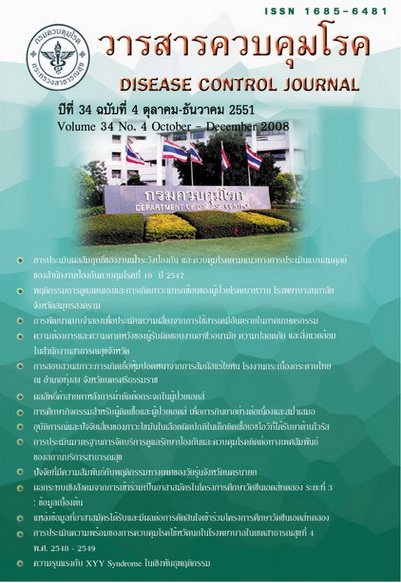Anti Tuberculosis Drug Resistance Surveillance Round 3 (2006-2007 ) and the Trend of Drug Resistance in Thailand
Keywords:
Anti Tuberculosis Drug Resistance in Thailand, Trend of drug resistanceAbstract
The 3rd Round of Drug Resistance Surveillance was conducted during 2006 - 2007. Seventy- six clusters in 56 provinces were recruited for the study through randomly custer sampling. 1,150 new smear positive cases and 194 cases with history of previously treated were enrolled. Multidrug resistance among new smear positive case was 1.65% and 34.54% among previously treated. Combined drug resistance to INH and RMP was 6.40%. In new smear positive cases any resistance of INH and RMP was 9.70% and 6.40% respectively while among previously treated was 44.30% and 35.10% for INH and RMP. Combined drug resistance of any H resistance and any R resistance was 14.70% and 7.30% Breaking data into regional setting, MDR in new smear positive cases was 0.78%, 1.06%, 2.93% and 3.24% in Central, Northeast, North and South respectively. But combined MDR was 9.28%, 5.95%, 4.41% and 3.17% in Central, Northeast, North and South. The findings of this round of the DRS emphasized the importance of strengthening TB control at all levels and in all stakeholders. In light of the level of resistance in the previously treated patients, the WHO CAT2 regimen for re-treatment in particular for the failure cases from CAT1 should be re-evaluated and revised if enough evidence based existed.
Downloads
References
2. Dyec, Watt Cj, Bleed DM, et al. Evolution of tuberculosis control and prospects for reducing tuberculosis incidence, prevalence and death globally. JAMA 2005; 293: 2767-75.
3. Maher D, Raviglione M. Global epidemiology of tuberculosis. Clin Chest Med 2005; 26: 167-82.
4. Raviglione MC, Harries AD, Msiska R, et al. Tuberculosis and HIV; current status in Africa. AIDS 1997; 11 (supply B): 115-23.
5. Ivan Bastian, Francoise Portaels. Multidrug-resistant Tuberculosis. Kluwer Academic Publishers Dordrecht /Boston /London 2000.
6. Guideline for the Programmatic management of drug- resistant tuberculosis. WHO/ HTM/ TB/ 2006. 361.
7. Crofton J, Mitchison DA. Streptomycin resistance in pulmonary tuberculosis. BMJ 1948; 2: 1009- 15.
8. Mitchison DA. Development of streptomycin resistance isolates of tubercle bacilli in pulmonary tuberculosis. Thorax 1950; 4: 144.
9. Canetti G.Present aspects of bacterial resistance in tuberculosis. Am Rev Respir Dis 1965; 92: 687-703.
10. Mahmoudi A, Iseman MD. Pitfalls in case of patients with tuberculosis. JAMA 1993; 270: 65-68
11. Kochi A, Vareldzis B, Syblo K. Multi- drug resistant tuberculosis and its control Res Microbiol 1993; 73: 219- 24.
12. Espinal MA, Kim SJ, Saurez PG, et al.Standard short-course chemotherapy for drug-resistant tuberculosis treatment outcomes in 6 countries. JAMA 2000; 283: 2537-45.
13. WHO. Guideline for surveillance of drug resistance in tuberculosis. WHO/ CDS/ CSR/ RMD/ 2003.3 Geneva: WHO 2003.
14. Mohamed Abdel Aziz, Abigail Wright, Adalbert Lazlo et al. The WHO/ International Union Against Tuberculosis And Lung Disease Global Project on Anti-tuberculosis Drug Resistance Surveillance. Lancet 2006; 368: 2142-54.
15. Drug resistance Tuberculosis in the South-East Asia Region.Status Report WHO, December 2007.
16. Tuberculosis in Thailand. Epidemiology and Program Performance 2001-2005, Department of Disease Control. Ministry of Public Health.
17. Anti-Tuberculosis Drug Resistance in the World. Report NO.3. The WHO/ IUATLD Global project on Anti-Tuberculosis Drug Resistance Surveillance. 1999-2002.
18. Hillemann D, Weizenegger M, Kubica T, Richter E, Niemann S. Use of the genotype MTBDR assay for rapid detection of rifampicine and isoniazid resistance in Mycobacterium tuberculosis complex isolates. J Clin Microbiol. 2005 Aug; 43(8): 3699-703.
19. Cavusoglu C, Turhan A, Akinci P, Soyler I. Evaluation of the Genotype MTBDR assay for rapid detection of rifampicin and isoniazid resistance in Mycobacterium tuberculosis isolates J Clin Microbiol. 2006 Jul; 44(7): 2338-42.
20. Miotto P, Piana F, Penati U et al. Use of genotype MTBDR assay for molecular detection of rifampicin and isniazid resistance in Mycobacterium tuberculosis clinical strains isolated in Italy. J Clin Microbiol. 2006 July; 44(7): 2485-91.
21. Cohn DL, Bustero F, Raviglione MC. Drug resistance in tuberculosis: review of the worldwide situation and WHO/ IUATLD'S Global Surveillance Project. Clin Infect Dis 1997; 24 (suppl 1): S 121-30.
Downloads
Published
How to Cite
Issue
Section
License
Articles published in the Disease Control Journal are considered as academic work, research or analysis of the personal opinion of the authors, not the opinion of the Thailand Department of Disease Control or editorial team. The authors must be responsible for their articles.






